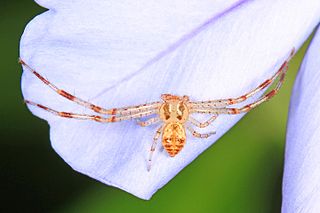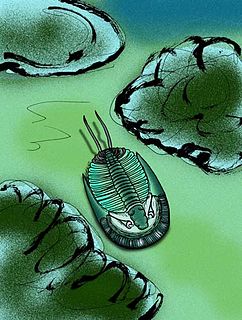Related Research Articles

Grenadiers or rattails are generally large, brown to black gadiform marine fish of the subfamily Macrourinae, the largest subfamily of the family Macrouridae. Found at great depths from the Arctic to Antarctic, members of this subfamily are amongst the most abundant of the deep-sea fish.

Phacopidae is a family of phacopid trilobites that ranges from the Lower Ordovician to the Upper Devonian, with representatives in all paleocontinents.

Phacops is a genus of trilobites in the order Phacopida, family Phacopidae, that lived in Europe, northwestern Africa, North and South America and China from the Late Ordovician until the very end of the Devonian, with a broader time range described from the Late Ordovician. It was a rounded animal, with a globose head and large eyes, and probably fed on detritus. Phacops is often found rolled up ("volvation"), a biological defense mechanism that is widespread among smaller trilobites but further perfected in this genus.

Paradoxides is a genus of large to very large trilobite found throughout the world during the Middle Cambrian period. One record-breaking specimen of Paradoxides davidis, described by John William Salter in 1863, is 37 cm (15 in). The cephalon was semicircular with free cheeks ending in long, narrow, recurved spines. Eyes were crescent shaped providing an almost 360° view, but only in the horizontal plane. Its elongate thorax was composed of 19-21 segments and adorned with longish, recurved pleural spines. Its pygidium was comparatively small. Paradoxides is a characteristic Middle-Cambrian trilobite of the 'Atlantic' (Avalonian) fauna. Avalonian rocks were deposited near a small continent called Avalonia in the Paleozoic Iapetus Ocean. Avalonian beds are now in a narrow strip along the East Coast of North America, and in Europe.

Misumenops is a common genus of crab spider with more than 50 described species.

The New Zealand fernbird or simply fernbird is an insectivorous bird endemic to New Zealand. In the Māori language, it is named kōtātā or mātātā.

Calymene Brongniart, 1822, is a genus of trilobites in the order Phacopida, suborder Calymenina, that are found throughout North America, North Africa, and Europe in primarily Silurian outcrops. Calymene is closely related to Flexicalymene, and both genera are frequently found enrolled. Calymene trilobites are small, typically 2 cm in length. The cephalon is the widest part of the animal and the thorax usually has 13 segments.

Asaphus is a genus of trilobites that is known from the Lower and Middle Ordovician of northwestern Europe.

Acaste is a genus of extinct trilobite of the order Phacopida which lived throughout the Silurian period. Though many species had been included, it now has only one species, Acaste downingiae. It is characterized by a convex dorsal surface, an absence of spines, a shortening of the head-shield and a general rounding off of all angles.
Crepicephalus is an extinct genus from a well-known class of fossil marine arthropods, the trilobites. It lived from 501 to 490 million years ago during the Dresbachian faunal stage of the late Cambrian Period.

Asaphiscus is a genus of trilobite that lived in the Cambrian. Its remains have been found in Australia and North America, especially in Utah.
Dienstina is a trilobite in the order Phacopida, that existed during the lower Devonian in what is now Germany. It was described by Richter and Richter in 1931, and the type species is Dienstina diensti, which the authors had originally assigned to the genus Phacopidella in 1923. The type locality was in Oberscheld, Rhenish Massif.

Ellipsocephalus Zenker, 1833, is a genus of blind Cambrian trilobite, comprising benthic species inhabiting deep, poorly lit or aphotic habitats. E. hoffi is a common trilobite mainly from central Europe.
Battus is a synonym for several agnostid trilobites, now assigned to other genera.
Entomostracites is a scientific name for several trilobites, now assigned to various other genera.
TrilobitesLink, 1807 is a disused genus of trilobites, the species of which are now all assigned to other genera.
ConocephalitesBarrande, 1852, is a disused name for a genus of trilobite, of which the species have now been reassigned to other genera. The name was introduced as a replacement for ConocephalusZenker, 1833, which was unavailable since Thunberg used it in 1815 for a genus of conehead bushcricket. Barrande however was unaware that Conocoryphe had already been proposed by Hawle and Corda in 1847.
ArionellusBarrande, 1850, is a disused name for a genus of trilobite. The name Arionellus was a replacement for ArionidesBarrande, 1847, itself a replacement for ArionBarrande, 1846, which was preoccupied because Férussac had already used it in 1819 for a genus of slugs.

Asaphus expansus is the type species of the asaphid trilobite genus Asaphus. It was previously classified as Entomostracites expansus before being split off into its own genus.

Entomaspididae is a family of harpetid trilobites that ranges from the Upper Cambrian to Lower Ordovician of marine strata in China and the United States.
References
- ↑ Moore, R.C. (1959). Arthropoda I - Arthropoda General Features, Proarthropoda, Euarthropoda General Features, Trilobitomorpha. Treatise on Invertebrate Paleontology. Vol. Part O. Boulder, Colorado/Lawrence, Kansas: Geological Society of America/University of Kansas Press. pp. O446 and O468. ISBN 0-8137-3015-5.
- ↑ Department of entomology, Texas A&M University. "Tobrilidae" . Retrieved 2014-01-03.